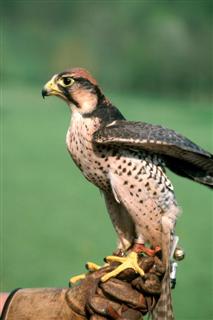Falcon - Lanner
Scientific Name: Falco biarmicus
Sat, 12th July, 2025 - 5:00 am GMT
Sponsor Ads:

Alternative Name
Scientific Name: Falco biarmicusBasic Info
Typically, Lanner Falcons grow to between 36 and 48 centimeters in length. Males reach an average weight of about 430 grams and females are larger at 750 grams. Lanner Falcons have rufous napes and crowns with white coloring over their underparts. These are streaked and spotted with brown or black. Their heads have narrow black caps and there are malar stripes below their eyes. Lanner Falcons have grayish or brown backs and their flight and tail feathers are of a gray color, which are sometimes barred black and the tail has a thin white edge. The wing coverts may be buff or whitish and are not patterned. The cere, orbital ring and feet are yellow or orange-yellow; they are bluish grey in juvenile birds. Lanner Falcons have bills, which are dark gray with blackish tips, and their eyes dark brown.
Health
Lanner Falcons are frequently confused with Peregrine Falcons, although they have less compact, longer, lighter body types and a more buoyant manner of flight. Lanner Falcons have slower wing beats than Peregrine Falcons and in soaring periods of flight, the tips of their wings appear convex or straight. Breeding Generally, Lanner Falcons breed between June and September and nest on cliffs. They are monogamous and courtship displays involve elaborate and swift flying and loud cries on the parts of both sexes. Sometimes, they will displace larger species of birds in order to utilize their nests! Lanner Falcons usually lay between one and five eggs that will hatch after about 32 days of incubation by both parents. The eggs are laid at two to three day intervals. The young Lanner Falcons remain near their parents for one to three months after they leave the nest.Habitat
Found predominantly in AfricaBehavior
Swift, lovely raptors, Lanner Falcons are amazingly fast and precise in flight. These beautiful birds are most commonly seen in Africa's open fields. Lanner Falcons are swift and highly maneuverable in flight. These falcons fly low over the ground and swiftly seize their prey, taking advantage of the element of surprise. They will also take advantage of prey injured by humans or other means. Lanner Falcons may be identified by their strident calls, which have a repeated "kak-kak" sound. During territorial or mating displays, Lanner Falcons will also emit a high pitched trilling noise. Generally, they live alone in grassland or agricultural areas although they are occasionally reported in pairs. They prefer areas near cliffs so they can nest; however, if there are no cliffs available they can use trees and power lines.Origin
AfricaHistory
The Lanner Falcon is found predominantly in Africa. They have also been reported in southern Italy, Greece and Asia Minor. Although Lanner Falcons have largely benefited from the clearing of grasslands opening their hunting range, they may be threatened due to ingestion of agricultural chemicals used in fields where they find their prey. Lanner Falcons are not loved by farmers, either, as occasionally they will take poultry for their prey. In populated areas, they can be harmed by people or electrocuted in power lines; however, in areas where the Lanner Falcon is protected it thrives.Common Foods
This aids them in catching small birds, their primary food. They will supplement their diets with small mammals or lizards.Sponsor Ads:
"The universe is not required to be in perfect harmony with human ambition." -- Carl Sagan
Falcon - Lanner
Coded by: BGID® | ALL RIGHTS RESERVED Copyright © 2000-2025
Disclaimer | Privacy | Report Errors / Contact | Credits








 Why haven't we as a collective earth met with aliens yet?
Why haven't we as a collective earth met with aliens yet?  World EcoSystem - Biodiversity Changes - Who is on board and who isn
World EcoSystem - Biodiversity Changes - Who is on board and who isn  Homosexual behavior stems from the mind or genetics?
Homosexual behavior stems from the mind or genetics?  The Best Text Adventure You Will Ever Play! The official site:
The Best Text Adventure You Will Ever Play! The official site:  Mouthwash - Mouthrinse - Mouth Sores - Healing Infections - Gingivitis
Mouthwash - Mouthrinse - Mouth Sores - Healing Infections - Gingivitis  Treatment for Depression
Treatment for Depression  Ultra radical and violent Islamist group that even rivals Al Qaeda
Ultra radical and violent Islamist group that even rivals Al Qaeda  An idea to have teachers who want to carry guns to school undergo some level of police training will be left up to local school districts and police departments.
An idea to have teachers who want to carry guns to school undergo some level of police training will be left up to local school districts and police departments.